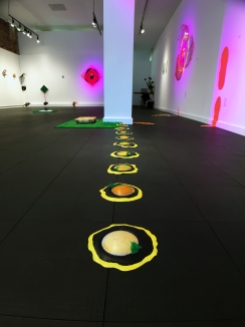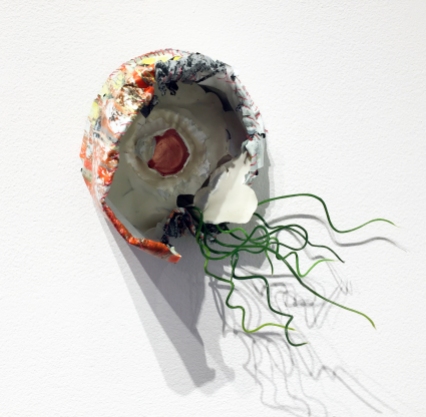“…more than a substance, plastic is the very idea of its infinite transformation; as its everyday name indicates, it is ubiquity made visible. And it is this, in fact, which makes it a miraculous substance: a miracle is always a sudden transformation of nature. Plastic remains impregnated throughout with this wonder: it is less a thing than the trace of a movement.”
-Roland Barthes, Mythologies
From our toiletries and sex toys to house paint, plastic has become the most prevalent surface layer of our daily lives, since Barthes’ foretelling essay on plastic published only half a century ago.
Most of the paints commercially produced and available to us today are made of plastic/synthetic polymers in terms of the chemical composition of binders and pigments used. This show, Plastisphere Earthlings, is Part II of my on-going project in the teleological exploration of paint, its plastic nature, and its relation to nature. Expanding from and further developing my earlier work based on queer theory and construction of identities through paint-made objects, this new body of work both metaphorically and physically confronts and juxtaposes the synthetic, plastic, and artificial nature of paint with vegetation. Introduction of this “natural” element momentarily disrupts the sterile, colorful, and shiny surface of plastic paint, providing a peculiar sense of wonder and resilience, much like seeing grass growing between cracks in concrete pavement. It shows us how much and how far we have come to change the environment and how we perceive that change, how quickly and easily we accept it or deny it as nature or being natural.
In illuminating this anomalous yet anticipated emergence of the anthropogenic substrate called the Plastisphere, symbols and codes found in road constructions are used to serve as a metaphor for our ever-so quickly changing environment. In the interest of animating and re-imagining plastic as the non-filial queer progeny of our love and desire for a sleeker, cleaner, and a more perfect world, I would like to present these paint-made, blobby, plastic objects as our fellow earthlings, traversing this artifactual earth that we share with other living things.
In the closing statement of her lecture titled, “the Queer Futurity of Plastic”, Heather Davis suggests: “…to acknowledge that the future will be queer, in terms of being completely disruptive, and also in the sense of learning from queer folks, who have never assumed biological reproduction or even continuance as a kind of possibility of hope, that futurity has to be completely reconfigured means finding a way to live with toxicity, extinction, and without the reassurance of an open horizon of the future. Toxicity provides a re-solution to the question of what to do with ambivalence of queerness only to the extent that does not represent a choice. It is already here; it is not a matter of queer political agency so much as to queer political state of the present.” Plastisphere Earthlings, Dakota Gallery, Bellingham, WA
Plastisphere Earthlings, Dakota Gallery, Bellingham, WA













